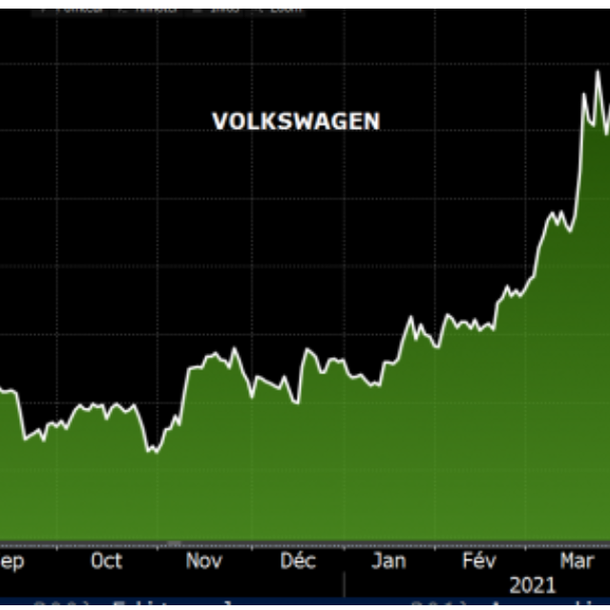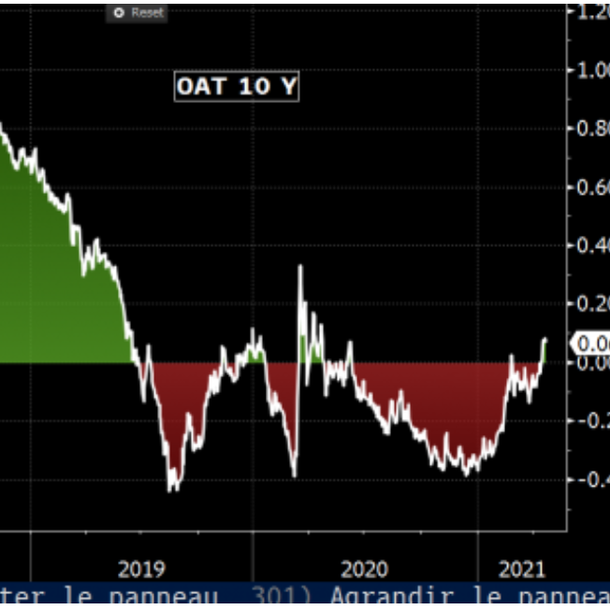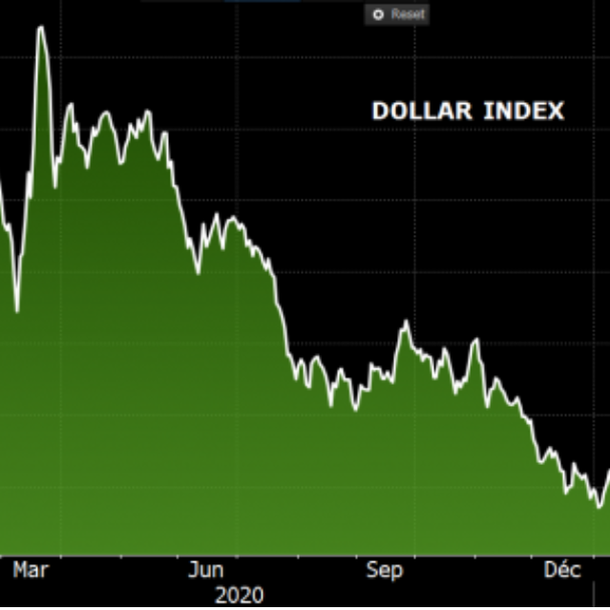|
Monday April 26 | Weekly market update |
 | Investors were nervous last week, amid a rising pandemic in Asia, mixed corporate results and the proposed near doubling of the capital gains tax in the US. The major indices seem to be resilient for now, but volatility could remain. |
| Indexes Over the past week, in Asia, the Nikkei dropped 2.3% while the Hang Seng gained 0.16% and the Shanghai Composite rose 1.4%. In Europe the red dominates. The CAC40 is down 0.5%, the Dax 1.3% and the Footsie 1.6%. Concerning the peripheral countries of the euro zone, Italy is losing 1.7%, Portugal 0.3% and Spain is stable. In the U.S., the proposed increase in taxation on capital gains has weighed somewhat on the trend. The Dow Jones fell by 0.6% over the last five days, the S&P500 lost 0.3% and the Nasdaq100 1.2%, pending the quarterly reports of the tech giants. The value segment continues to perform well, as does the MSCI World value index (see chart). MSI world value index  |
| Commodities Plunged by the unexpected rise in inventories in the United States, oil prices have taken a nosedive this week. Operators are also closely scrutinizing the health situation in India, the third largest consumer of black gold, where the number of contaminations is exploding. The supply disruptions in Libya have thus been relegated to the background. Brent crude is trading at USD 65.2 per barrel, compared with USD 61.3 for WTI. On the precious metals side, gold regained some height thanks to the stabilization of bond yields. But the real star of the week was palladium, which made a new high of over USD 2900. Industrial metals continue their rally. Copper climbed to USD 9400 per metric ton and aluminum rose to USD 2370. Nickel and tin, on the other hand, are stabilizing at USD 16,000 and USD 28,400 respectively. |
| Equities markets The stock market performance of Volkswagen since the beginning of the year is excellent. It achieves the best performance of the Euro-Stoxx 50. This automotive giant, which owns brands such as Audi, Porsche and Lamborghini, needs no introduction. The German car manufacturer is up more than 50%. A value stock par excellence, it was able to take advantage of the craze for this type of asset at the beginning of the year. With the ambition to restore its image after the "diesel gate", six years earlier, the company wants to become the world leader in electric cars from 2025. To achieve this, the German company has announced a colossal investment of 46 billion euros over five years to reach this goal. In addition, the company, which is worth 130 billion dollars, wants its sites in the European Union to be supplied with 100% electricity from renewable sources by 2023. However, like other players in the automotive sector, Volkswagen is suffering from a production slowdown due to the shortage of semiconductors. Events that could slow down this nice progress by 2021. Volkswagen share price increase  |
| Bond market The guardians of the euro held their monthly meeting to deliberate on the way forward on monetary policy, with chairwoman Christine Lagarde taking the opportunity to say that it was premature to change course. The European economy therefore continues to rely on significant monetary support, given the delays in the implementation of the European Recovery Mechanism. At the same time, spreads of peripheral debt instruments with the Bund have tightened moderately in reaction to the likely ratification of German participation in the European Economic Recovery Fund. While the yield on German debt remained stable at -0.27%, sovereign bonds from the southern part of Europe were more sought after by investors, such as the Italian (0.77%) and Spanish (0.37%) 10-year bonds. On the other hand, the French OAT moved into positive territory and saw its yield rise to 0.07%. In the United States, Federal Reserve members, in their blackout period before the FOMC meeting scheduled for next Wednesday, cannot comment on monetary policy issues. Again, a change in monetary policy stance is unlikely. The Tbond yields 1.57%, several basis points below its recent peak at 1.75%. The OAT is back in positive territory  |
| Forex market Treasury yields were key to fueling the dollar's surge against its major counterparts in the first quarter, but now appear to have peaked. This sets up a losing scenario for the U.S. currency, as traditional economic fundamentals favor other currencies, as do President Joe Biden's plans for massive fiscal spending. Predicting U.S. 10-year yields is akin to predicting the greenback's path with the knowledge that Treasury yields are not expected to rise above 2%, which would be above the U.S. potential growth rate. The USD/JPY exchange rate has lost nearly 250 points since its March peak. Across the Atlantic, the Canadian dollar gained more than 1% against the greenback after the Canadian central bank said it would reduce its asset purchases to CAD 3 billion per week from the current CAD 4 billion. It is the first central bank to make the move. The USD/CAD parity which was trading around 1.2650 fell below 1.25 within minutes of the announcements. In Europe, the euro rebounded against the dollar (1.2050) and kept a low volatility against the pound sterling at GBP 0.865. Investors believe that the ECB will not clearly define its exit plans before the June meeting. Among the emerging currencies, the Indian rupee is still suffering from the health situation in its country and stalled again against the dollar at INR 75.40. Dollar shows a fragile pattern  |
| Economic data Over the past week, few statistics were on the agenda. In addition to the ECB's decision to keep its rates unchanged and its PEPP program, the manufacturing and services PMI indices exceeded expectations in the euro zone, at 63.3 and 50.3 respectively. They came in at 49.2 and 50.4 in France, and 66.4 and 50.1 in Germany. In the United States, weekly jobless claims were better than expected (547K against 607K expected). Leading indicators rose by 1.3%. The Flash PMI manufacturing and services indexes came in at 60.6 and 63.1. On the housing front, existing home sales were slightly below expectations (6.01M vs. 6.18M expected) and new home sales were better than expected at 1021K. |
| Q2 should be in line with expectations The stock market has always been the focus of investors' expectations. At the dawn of the second quarter, synonymous with a probable generalized deconfliction and a return to freedom of movement, it seems appropriate to ask whether the bullish trajectories of equities, and more specifically those of value or cyclical stocks, have not overestimated the future economic reality. If the economic recovery is as good as hoped, indices could continue to rise, or at worst consolidate healthily. In the opposite scenario, index adjustments would be inevitable, especially after so much hope on markets. But these more or less violent adjustments could once again be slowed down by central banks. Monetary institutions will remain on the lookout to compensate, as they have been doing for a decade, for the predominance of fiscal policy as a growth stimulant. The safety nets remain, especially since volatility is expected to gain a few points during this next quarterly episode. |

 By
By 















